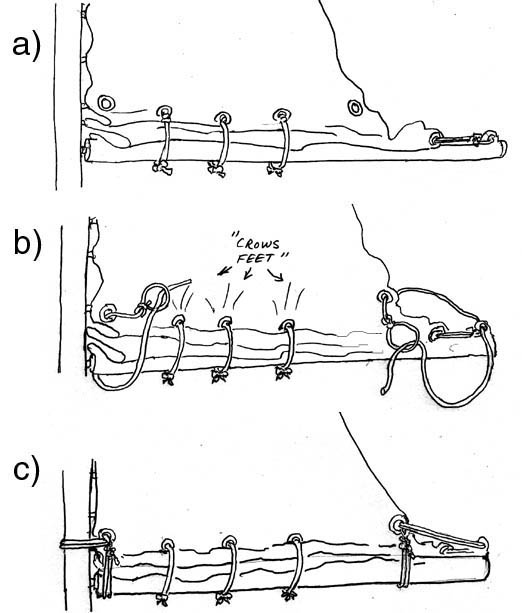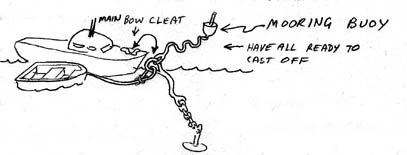
This is Captain's Manual for sloop Victoria, a Victoria 18 sailboat. All official captains of Victoria must be familiar with the material in this manual, and as a pre-requisite, all the information in the Victoria Crewmember's Manual.
Stop at the house, pick up life jackets, oars, and shore box, which should contain chart, water, and RUM! (shiver me timbers!). Myers's Rum is the official rum on board Victoria! A cooler containing Ipswich Ale and sandwiches is advised for longer sails.
Proceed to Tuck's Point with vehicle that has Manchester resident sticker for parking at Tuck's Point. Load up the Toad (row boat) and wear life jackets. The registration for Victoria is pasted to the inside of the shore box. Row out to Proctor's Cove, mooring E-005.
Attach the bowline of the Toad through the loop in Victoria's mooring line, using a bowline hitch. Make sure that all gear passes through the same gap in the pulpit rail, so as not to get hung up when you cast off.

Remove the SaltSwarther © and stow in port-side torpedo tube. Remove the bucket protecting the engine, stow below in bow compartment. Stow oars from the Toad in starboard side torpedo tube. Stow the shore box in starboard side torpedo tube, have all crew deposit valuables in the shore box.
Check bilge for water, pump out if necessary. If unusually large quantity of water is found, determine if it is salt or fresh water, and investigate possible leaks.
If there is a lot of water in the bilge, or if the boat is overloaded, this will manifest itself by water coming up the cockpit drains. If observed, investigate further!
Examine fuel situation in poop hatch, make sure fuel line is connected to a non-empty tank, and that the tank vent is open.
If returning to Tuck's Point to pick up passengers, rig fenders, bowline, and stern line. If heading straight out, rig Jib or Genoa, furled, ready to set. Attach tack shackle to fore'ad chain plate, and clip Hanks onto forestay. Attach Jib halyard to jib head, use slack halyard to furl jib on foredeck. Reeve jib sheets outboard of the shrouds, through the jib sheet blocks, and tie a Figure Eight Knot in the ends.

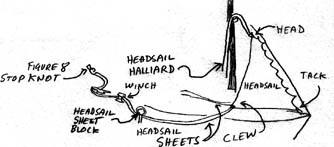
Release main sheet, rig boom to port side, pull main sheet snug.
Occasionally check oil by removing engine top cover to find dip stick.
Choke on. Start engine, warm up, choke off.
Check green oil pressure light on. Check water stream spilling from engine. If either should fail to appear, shut down engine immediately and investigate.
NOTE: Do not operate engine when Victoria is "down by the bows", or nose heavy, so that the engine flange (just above the propellor) is out of the water, because the engine sucks cooling water from below that flange, and the engine will overheat if it is allowed to suck air. If you send a crewman up to the bows to rig a bowline or set the jib, compensate for the weight shift by moving yourself or other crew further aft. The command "Weight aft!" means all crewmen shift their weight astern.
Cast off, steer clear of mooring gear. Do not pass between the Toad and the pick-up buoy, as you may snag the pick-up line. Perhaps it is easiest to start in reverse and back away from the mooring gear.
When moving forward, you can steer with either the engine handle, or with the tiller. Once underway, set the engine to the center and steer with the helm. Beware that if you leave the engine idling, and in gear, it tends to shake and shudder and turn to one side, which can cause trouble if you don't notice. If you are sailing, and no longer need the engine, it is best to leave it in neutral so it can't cause trouble.
When moving astern, with the engine in reverse, be aware that the rudder will tend to counteract your steering with the engine. If you turn the engine to port, say, (engine handle to starboard, engine in reverse gear) the rudder will tend to flop to starboard (helm a-port), and oppose the engine. Therefore when maneuvering in reverse, you should either secure the tiller amidships with rope, or ask a crewman to hold it amidships, or for maximum maneuverability, operate the engine handle and helm simultaneously in parallel: Engine handle to port, helm a-port; engine handle to starboard, helm a-starboard. That way you maintain steerage and turning effect even when the engine is put in neutral gear.
To shut off engine, set throttle to idle, press the red kill switch.
Before raising engine check fuel hose. If it has extra slack, (a), then it will kink when the engine is raised (b). To prevent kinking, tuck excess fuel line down below engine mount (c) so that engine can be raised (d).

To raise engine, reach back starboard aft, just abaft the engine raising hinge, and press release lever down while raising engine. The engine can snap to two pre-set elevations.
Make sure the mains'l sheed is uncoiled and free of its jam cleat before raising sail. Don't forget the battens. Unfurl sail, raise with halyard, feed toggles into mast track. Leave the sheet free until the sail is all the way up and belayed.
Unfurl, make sure sheets are free, haul haliard to raise sail, belay on cleat, trim the sheet.
Make sure that the helmsman takes an occasional peek behind the heads'l, to make sure there is no traffic approaching from that direction. Avoid running over lobster pot buoys, especially when the engine is in the water.
Sailboats have right-of-way over power boats, and rowboats have right-of-way over sailboat. A sailboat motoring with its motor is considered a motor boat, whether or not the sails are set.
For boats of equal priority (e.g. two sailboats) the one to the right has the right-of-way (a). For a head-on approach, a sailboat on the starboard tack has priority over a sailboat on the port tack. (b).

When a boat is approaching from an angle up ahead, (c) you can tell that you are on a collision course if the Relative Bearing to that vessel remains constant (d). If you observe the vessel moving RELATIVE TO THE MOST DISTANT BACKGROUND then you are not on a collision course. If it appears to be drifting right to left, it will continue drifting that way and pass safely off to your left, whereas if the vessel appears to be drifting left to right, then it will pass safely off to your right.

In case of potential conflict, usually TURN TOWARD THE OTHER VESSEL'S STERN to get out of the way most expeditiously. Be careful — even if there is no collision risk, many week-end sailors don't understand the above procedure, and they will tend to instinctively turn a-port (left) in case (c) just because the vessel is off to starboard, which can make matters worse by putting them on a true collision course!
The captain must know where he is at all times, and must be aware of all submerged obstacles in the viscinity, and the approximate range and bearing to those obstacles. There is NO EXCUSE for running aground on a submerged rock!
Whenever you see a nearer buoy lining up with a recognizable feature farther away, a smoke stack, or island, or whatever, do not miss the opportunity to trace the sightline on the chart to get a Line of Position (LOP). The intersection of two such sightlines gives an exact position.
There is a compass in the shore box, which can be mounted on the after cabin wall, starboard side. Be sure to tumble the compass on its gimbals so that the Lubber Line (etched line that shows the straight-ahead direction) on the compass shows aft.
You can take magnetic bearings to distant objects to establish a LOP by sighting over the top of the compass and reading the bearing in that direction. Be sure to use the magnetic compass rose on the chart.
Buoys are generally red or green. The red ones mark the right side of channels in to a harbor, the green ones mark the left side. Use the mnemonic: Red Right Returning to note that the Red ones are on your Right when you are Returning to the harbor. Buoys are marked on the chart as a little diamond, magenta for red, green for green, over a small circle. The circle marks the actual location of the buoy. Buoys are also marked with numbers that also appear on the chart for precise identification. The red buoys are generally conical, and are called Nuns, and are assigned Even numbers, the green ones are generally cylindrical, are called Cans, and are assigned Odd numbers. The red nun #2 is marked on the chart as N "2", whereas the green can #3 is marked C "3".
Daymarkers are fixed to the ground instead of floating, but are painted red or green, and assigned numbers like the buoys. They appear on the chart as a magenta or green triangle.
Do not sail outside of marked channels unless you know your precise location with absolute certainty, the depth at that location, and the height of the tide. Always be suspicious of white water, as it might indicate the presence of a submerged rock.
Rig bowlines and sternlines, pass bowline through the fairlead and aft outboard of the stays. Rig fenders on anticipated side. The command is: "Rig fenders for starboard-side-to", or "port-side-to". For neater appearance, keep fenders flipped inboard until you are about to need them.
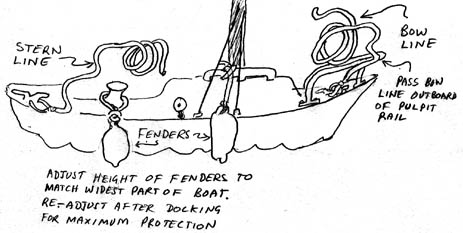
Approach dock slowly, and throw engine in neutral or reverse, to drift in the last 10 feet or so. Have crew ready to jump ashore on your command, with mooring line in hand, and have them haul in and belay as soon as they arrive on the dock.
If the maneuver goes awry, be ready to command "Abort! Abort! All hands on board!" or "Fend off bows!", "Fend off stern!" to soften or divert impending collisions.
Tie up to the dock with bowlines and sternlines either lateral, as "breast lines" (as shown below) or angled out more ahead and astern. Two Half Hitches On the Bight is a good knot for securing to the dock. Re-adjust fenders to offer maximum protection.
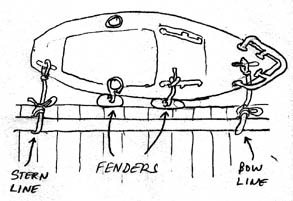
Rig additional Spring Lines, to restrict forward or aftward motion of the boat, especially when there is a particular collison hazard in some direction.
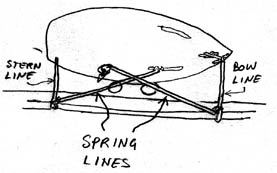
IMPORTANT! Notice whether a dock is a floating dock that rises and falls with the tide, (most all of them are) or if it is a fixed dock. If it is the latter, then you MUST be aware of the state and trend of the tide, and factor that in the length of your mooring lines. If you tie up tight on a high tide, you could come back to find the boat hanging by the cleats!
Remove spring lines, and man bow and stern lines, command "Stand by to cast off". Get engine started, and when running with choke off, call "Cast off bow!", "Cast off stern!", or "Cast off and shove off bow!" etc.
Be careful pulling away from a dock. If you turn hard away from the dock, the stern is liable to smash up against it, so make your first turn gentle and angle away from the dock. When space is limited, it is sometimes easier to back out, because the taper of the bow gives it more clearance from the dock.
Another simple solution is to order the bowline man to "Cast off and
shove off!", push the bow out laterally to point you away from the
dock. But be ready with your heel against the dock, to prevent the
stern from colliding with the dock as the bow swings out.
For particularly challenging situations, or perhaps just to add an
elegant new maneuver to your repetoire, you may wish to try the
Pivoted Sway-Turn. First, drop the bowline crewman on the dock, with
orders to take a turn around a dock cleat to belay the line
(a). Once secured, the engine is put into reverse at idle
throttle, to provide a gentle sternward thrust to keep tension on the
bowline, without actually moving astern. Now if you cant the idling
engine this way or that, it will gently sway the boat in a beamwise
direction, either away from or toward the dock, pivoting around the
belayed bowline (b). So, for departure from a tight dock with
obstacles ahead and astern, do a pivoted sway-turn to pull the stern
out away from the dock, then put the engine in neutral, have your crew
climb aboard by the bow, (c) and back out of the tight spot.
You can use the Pivoted Sway-Turn also for arriving at a dock with
limited maneuver room. Pull up at right angles to the dock, and drop
off the bowline crewman (c) to belay the bowline at the foreward end of
the available dock space. Then do a Pivoted Sway-Turn (b) to sway up to
the dock broadside (a).
As a point of terminology, there are three directions of
rotation of a boat, Roll, Pitch, and Yaw. Roll is
rotation around the long axis, pitch is up and down of the bow and
stern, and yaw is rotation about the vertical axis, or turning in
different directions. The corresponding terms for directions of
translation are known as Heave, Surge, and Sway,
where Heave means vertical motion, Surge is fore-and-aft motion, while
Sway means lateral or beamwise motion.
The cockpit is connected straight through to the sea by the cockpit
drains, so that if you "ship a sea" (take on water in the cockpit) it
will drain back out again automatically. The water level in the
cockpit drain is level with the water level around the boat. If the
boat is overloaded, this will be apparent by water rising in the
cockpit floor. Do not sail when overloaded!
All water that enters the cabin or poop hatch (Lazarette) drains into
the bilge. The FIRST THING to do when coming aboard is to open the
bilge access hatch and check the bilge water level, and pump out as
necessary. Pull out the bilge output hose and point it over the side
before pumping.
In case the cockpit drain pipes should develop a leak, there is a
Sea Cock on each side to shut off the cockpit drain and seal
the hull. This valve should be greased every year.
The first sign that you are taking on water in the bilge, is rising
water in the cockpit because the boat will ride lower in the
water. If this is observed, immediately check the bilge, and if a leak
is suspected, shut off both cockpit drain sea cocks.
Each sea cock has two handles, an "L" shaped one, and a "T" shaped
one. The L handle is the valve itself, open when vertical, closed
when horizontal. The T handle is a friction lock for the
valve. Release the friction (rotate counter-clockwise) before turning
the L handle, and tighten again afterwards.
Have the crew grab the pick-up buoy and haul on the pick-up line to
find the fatter mooring line. Haul the mooring line on deck, thread
through the Fairlead
and loop over the main bow cleat. Leave pick-up buoy and lines on the
foredeck.
Stow headsails in port side torpedo tube. Furl mains'l with main
haliard, center boom and tighten main sheet.
Remove the shore box, oars, cooler, and engine fending bucket, from
cabin and load onto Toad.
Check bilge before leaving boat
Check all switches OFF (down) on electrical panel.
Close cabin hatch (top) but leave cabin doors open for ventilation if
the SaltSwarther is to be used.
Rig SaltSwarther © with "collar" around the mast, secure
with round turns and a square knot. Tie to handrails with clove
hitches, to jib sheet blocks with two half hitches, and belay to cleats.
Raise engine up one notch, allow to drain for a long time. Then raise
engine to highest notch. Rig engine-fending bucket over propellor,
secure with its lanyard.
Victoria is equipped with a Danforth Anchor stowed in the cabin
way up fore'ad in the bow compartment, with its anchor line. To deploy
the anchor, first haul it out to the cabin or cockpit, and secure the
anchor line to the anchor using the anchor shackle.
The anchor cable can be secured with Stops, i.e. short lines
with square knots. Settle the coil in a stable and dry location and
remove the stops. Then secure the bitter end to the bow cleat (or
other secure attachment) and the other end to the anchor. Bring the
anchor out to the fore-deck ready to drop.
After the boat comes to a stop, drop the anchor till it hits bottom,
note the length of cable let out, = L. Then, slowly let out an
additional 2L for a total of 3L. The reason for the extra is that the
anchor holds only against a horizontal pull. Make sure the
anchor is holding by sighting a near and far object that are aligned,
to see if the boat is drifting. Then check again a few minutes later.
If anchoring for an extended period, factor in the tides. Leave more
line out at low or rising tide.
Anchor will not hold reliably on ROCKY bottom, and may even get jammed
and thus lost. If it gets permanently jammed, attach a buoy to the end
of the anchor line (e.g. a fender) and come back later with SCUBA gear
to recover the anchor and line.
When raising the anchor, scrub off and rinse with a bucket of water if
she comes up all muddy. Coil up the anchor cable neatly, and install
stops, or make sea gasket coil.
You can tell that it is time to reef the mains'l when the wind is so
strong that the boat heels over dangerously steep, and yet when you
let out the sheet to bring her back towards vertical, the sail luffs
and shudders violently, stressing the gear. With reduced sail, the
boat will not heel dangerously when the main sheet is hauled in to
stop the luffing.
Heave to under backed jib, preferably in sheltered water, and lash the
helm to leeward.
Lower the main halliard a bit, and secure the reef
points under the boom using of course, Reef Knots!
(a). Don't pull them so tight that they can't slide along the
boom.
Secure the foreward reef cringle to the boom below, and to the mast
ahead, with a Reefing Tack Line. For example put a bowline hitch in
the end of the line, thread it through the foreward reef cringle, loop
it under the boom (b), back up through the loop of the bowline, then
around the front of the mast and back to the bowline loop, and secure
to the loop with perhaps a pair of half-hitches (c).
Finally, rig the reef outhaul between the aft reef grommet and the end of
the boom, using a Reefing Clew Line, with a cross-turn under
the bottom of the boom. For example put a bowline hitch in the end of
the line, thread it through the after reef cringle, then through a
hole in the end of the boom (the clew outhaul shackle will serve) and
back foreward through the bowline loop, then down under the boom and
back up to the bowline loop, and finally secure with perhaps two
half-hitches. Do not tighten it too hard down to the
boom. If the outhaul tension is right, there will be no "crows feet"
at the reef point grommets, and the clew has an equal balance of
outward and downward tension.
Haul up the main halliard, haul in the main sheet, and she's all set!
Pivoted Sway-Turn

Bilge and Cockpit Drainage

Mooring at Manchester


Securing the Boat

Anchor Use

Dropping Anchor
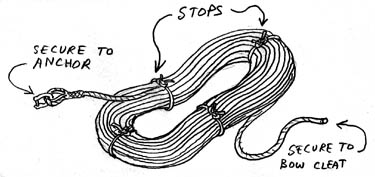

Reefing
Reefing Procedure
